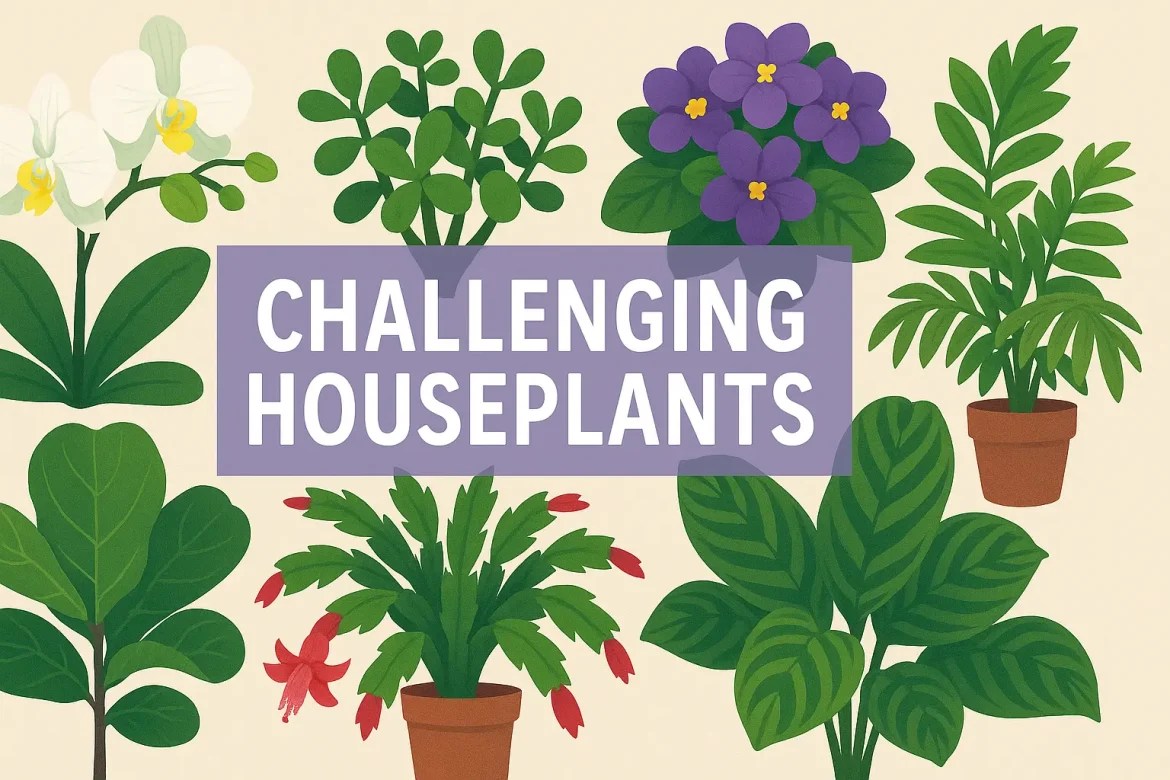Houseplants: A Guide to Growing Challenging Varieties
Introduction
Houseplants are a great way to add life and beauty to your home, but not all houseplants are created equal. Some varieties are more challenging to grow than others, requiring specific care and attention to thrive. In this article, we’ll explore some of the most challenging houseplants and provide tips on how to care for them successfully.
Orchids
Orchids are popular houseplants known for their exotic flowers. However, they can be finicky and require specific care to bloom and stay healthy.
- Watering: Orchids should be watered when the potting mix is almost dry to the touch. Avoid overwatering, as this can lead to root rot.
- Light: Orchids prefer bright, indirect light. Avoid placing them in direct sunlight, as this can burn their leaves.
- Humidity: Orchids thrive in humid environments. You can increase humidity by using a humidifier or placing the plant on a tray of pebbles filled with water.
- Temperature: Most orchids prefer warm temperatures between 65-85 degrees Fahrenheit.
Jade Plants
Jade plants are known for their thick, succulent leaves and are often given as gifts for good luck and prosperity. However, they can be challenging to care for if you don’t provide them with the right conditions.
- Watering: Jade plants should be watered sparingly, allowing the soil to dry out completely between waterings. Overwatering can lead to root rot.
- Light: Jade plants need bright, indirect light. Avoid placing them in direct sunlight, as this can scorch their leaves.
- Soil: Jade plants prefer well-draining soil that is slightly acidic.
- Fertilizing: Jade plants should be fertilized monthly during the growing season with a balanced fertilizer.
African Violets
African violets are charming houseplants with velvety leaves and colorful flowers. However, they can be sensitive to changes in their environment and require specific care to thrive.
- Watering: African violets should be watered from the bottom, allowing the water to soak up into the soil. Avoid getting water on the leaves, as this can lead to rot.
- Light: African violets prefer bright, indirect light. Avoid placing them in direct sunlight, as this can burn their leaves.
- Humidity: African violets prefer humid environments. You can increase humidity by using a humidifier or placing the plant on a tray of pebbles filled with water.
- Temperature: African violets prefer warm temperatures between 65-75 degrees Fahrenheit.
Christmas Cactus
Christmas cactus is a popular holiday plant that is known for its showy flowers. However, it can be challenging to get it to bloom if you don’t provide it with the right conditions.
- Watering: Christmas cactus should be watered sparingly, allowing the soil to dry out slightly between waterings. Overwatering can lead to root rot.
- Light: Christmas cactus prefers bright, indirect light. Avoid placing it in direct sunlight, as this can scorch its leaves.
- Temperature: Christmas cactus needs a period of cool temperatures in order to bloom. About 6-8 weeks before you want it to flower, reduce the temperature to around 50-55 degrees Fahrenheit.
- Fertilizing: Christmas cactus should be fertilized monthly during the growing season with a balanced fertilizer.
Fiddle Leaf Fig
Fiddle leaf figs are popular for their large, showy leaves that add a tropical feel to any room. However, they can be challenging to care for and require specific conditions to thrive.
- Watering: Fiddle leaf figs should be watered when the top inch of soil is dry to the touch. Avoid overwatering, as this can lead to root rot.
- Light: Fiddle leaf figs prefer bright, indirect light. Avoid placing them in direct sunlight, as this can burn their leaves.
- Humidity: Fiddle leaf figs prefer humid environments. You can increase humidity by using a humidifier or placing the plant on a tray of pebbles filled with water.
- Temperature: Fiddle leaf figs prefer warm temperatures between 65-80 degrees Fahrenheit.
Calathea
Calathea plants are known for their bold, colorful leaves that add a touch of the tropics to any room. However, they can be challenging to care for and require specific conditions to thrive.
- Watering: Calathea plants should be watered when the top inch of soil is dry to the touch. Avoid overwatering, as this can lead to root rot.
- Light: Calathea plants prefer bright, indirect light. Avoid placing them in direct sunlight, as this can scorch their leaves.
- Humidity: Calathea plants prefer humid environments. You can increase humidity by using a humidifier or placing the plant on a tray of pebbles filled with water.
- Temperature: Calathea plants prefer warm temperatures between 65-80 degrees Fahrenheit.
Indoor Ferns
Indoor ferns add a touch of elegance and lushness to any room. However, they can be challenging to care for and require specific conditions to thrive.
- Watering: Ferns should be watered regularly, allowing the soil to dry out slightly between waterings. Avoid overwatering, as this can lead to root rot.
- Light: Ferns prefer bright, indirect light. Avoid placing them in direct sunlight, as this can burn their leaves.
- Humidity: Ferns prefer humid environments. You can increase humidity by using a humidifier or placing the plant on a tray of pebbles filled with water.
- Temperature: Ferns prefer warm temperatures between 65-80 degrees Fahrenheit.
